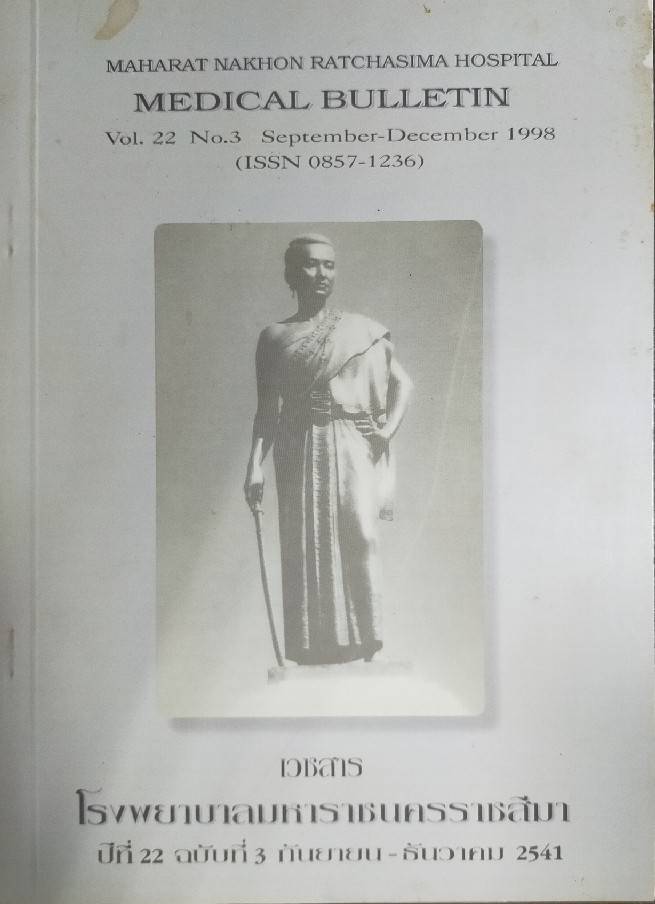Antibiotics in Near Drowning Patients
Main Article Content
Abstract
Althouh prophylactic antibiotics are not recommended for near-drowning victims, in some instance,antibiotics may be life saving treatment. Objective. To find out the conditions that antibiotics may be used as prophylaxis and which ones are appropriate. Methods. A retrospective review was undertaken of near-drowning patients (1994 through 1997). All were classified by clinical sign on admission as class A, B or C. Sex, age, admission day and bacterial culture results were analyzed together with result of treatment. Results. Class A and B patients were found to be low risk of infection and mortality. Most of class C patients were infected. Sputum and blood culture results were gram negative bacilli which were susceptible to prophylactic antibiotics used, ceftazidime and co-trimoxazole. Conclusion. Antibiotic prophylaxis may be appropriate in class C and ceftazidime together with co-trimoxazole are suitable pairs for Buriram Province near-drowning patients.
Article Details

This work is licensed under a Creative Commons Attribution-NonCommercial-NoDerivatives 4.0 International License.
References
สถิติสาธารณสุข พ.ศ. 2539. ตายจากตกน้ำรวมถึงการจมน้ำ. กระทรวงสาธารณสุข 2539:77.
สุพิชชา แสงโชติ. ปัจจัยที่มีผลต่อการเสียชีวิตและการเกิดความพิการในผู้ป่วยเด็กที่จมน้ำ โรงพยาบาลสมเด็จพระปิ่นเกล้า. วารสารแพทย์นาวี 2534;31(3):11-26.
Rumbak MJ. The etiology of pulmonary edema in fresh water near-drowning. Am J Med 1996;14:176-9.
Van Berkel M, Bierens JJ, Lie RL, de Rooy TP, Kool LJ, van de Velde EA, Meinders AE. Pulmonary edema, pneumonia and mortality in submersion victims: a retrospective study of 125 patients. Intensive Care Med 1996;22:101-7.
Enter PT, Dolan MJ, Dolan D, Farmer JC, Melcher GP. Near-drowning associated aeromonas pneumonia. J Emerg Med 1996;14:737-41.
Gonzalez Rothi RJ. Near drowning: consensus and controversies in pulmonary and cerebral resuscitation. HeartLung1987;16:474-82.
Kennedy GA, Kanter RK, Weiner LB, Tompkins JM. Can early bacterial complications of aspiration with respiratory failure be predicted? Pediatr Emerg Care 1992;8:123-5.
Bowon C, Tantrapom W,Palaruk P,Ampanpong T. Pulmonary infection in near-drowning with ARDS: the difference between salt and fresh water group. วารสาร โรคติดเชื้อและยาต้านจุลชีพ 2537;11:61-3.
Mangge H, Plecko B, Grubbauer HM, Popper H, Smolle Juttner F, Zach M. Late-onset miliary pneumonitis after near-drowning. Pediatr Pulmonal 1993;15:122-4.
เกษียร ภังคานนท์, อรรณพ บินมาเอน,สมชาย ผลเอี่ยมเอก. Secondary drowning. สารศิริราช 2522;31:1914-25.
Graf WD, Cummings P, Quan L, Brutocao D. Predicting outcome in pediatric submersion victims. Ann Emerg Med 1995;26:312-9.
Vernon DD, Banner WJr, Cantwell GP, Hdzman BH, Bolte RG, Dean JM. Streptococcus pneumoniae bacteremia associated with near-drowning. Crit Care Med 1990;18:1175-6.
Barr AM, Taylor M. A case of drowning. Anaesthesia 1976;31:651-7.
Pruekprasert P, Jitsurong S. Case report: septicemia mellioidosis following near drowning. Southeast Asian J Trop Med Public Health 1991;22:276-8.


